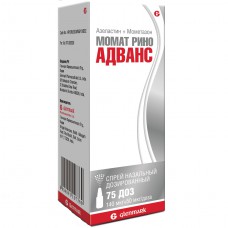Expiration date: 03/2025
Dosage form
White or almost white suspension
Composition
1 dose of spray contains:
Active substances: azelastine hydrochloride 140 mcg, mometasone furoate is 50 mcg.
Excipients: cellulose microcrystalline (Avicel RC-591) - 0,910 mg, carmellose sodium -0,021 mg, dextrose - 3,500 mg Polysorbate-80 - 0,0175 mg, benzalkonium chloride - 0,014 mg disodium edetate - 0,035 mg neotame - 0,0007 mg, citric acid monohydrate - 0,0105 mg, sodium citrate - 0,021 mg, purified water - up to 70 mg.
Pharmacological action
Azelastine, a derivative of phthalazinone, is an antiallergic lasting effect. Azelastine is a selective H i-gistaminoblokatora, has anti-histamine, anti-allergic and membrane stabilizing effect that reduces capillary permeability and exudation, stabilizes the membranes of fat cells and prevents the release of biologically active substances (histamine, serotonin, LEU-katriena, factor, activating platelets, etc.) that cause bronchospasm and contributing to the development of early and late stage of allergic reactions and inflammation.
Mometasone is a synthetic glucocorticosteroid (GCS) for local use. Anti-inflammatory and anti-allergic effect when used in the doses in which there is systemic effects. Inhibits the release of mediators of inflammation. It increases production of lipomodulin, which is an inhibitor of phospholipase A, which causes the reduction in the release of arachidonic acid and, respectively. inhibition of synthesis products metabolism arahidonova acid — cyclical endoperekisey, prostaglandins. Warns boundary accumulation of neutrophils, reduces inflammatory exudation and production of lymphokines, inhibits the migration of macrophages, reduces the processes of infiltration and granulation. Reduces inflammation by reducing the formation of substances of chemotaxis (influence on the "late" reactions of allergies), inhibits the development of allergic reactions immediate type (due to inhibition of production of metabolites of arachidonic acid and a decrease in the release of fat cells mediators of inflammation).
Pharmacokinetics
Azelastine hydrochloride. Bioavailability after iternazionale use is about 40 %. The maximum concentration (Cmax) in plasma after intranasal application achieved after 2-3 hours. When applied intranasally in a daily dose of 0.56 mg azelastine hydrochloride average equilibrium concentration of azelastine hydrochloride in plasma 2 hours after acceptance is 0.65 ng/ml. Doubling the total daily dose to 1.12 mg leads to a sustainable average concentration of azelastine in the plasma, equal to 1.09 ng/ml. However, despite the relatively high suction patients on systemic exposure after intranasal application approximately 8 times lower than after oral administration a daily dose of 4.4 mg azelastine hydrochloride, which is a therapeutic oral dose for the treatment of allergic rhinitis. Intranasal use in patients with allergic rhinitis causes an increase the level of azelastine in plasma compared with healthy subjects. Other pharmacokinetic data were studied when applied inside. Communication with the blood supply 80 - 90%. It is metabolized in the liver by oxidation with the participation of zitohroma R450 with the formation of the active metabolite desmethylazelastine. Write mainly kidneys in the form of inactive metabolites. The elimination half-life (T1/2) of azelastine, about 20 hours, its active metabolite desmethylazelastine - about 45 hrs
Mometasone furoate. In intra application system bioavailability Moneta zone furoate is < 1% (with sensitivity of the method of determination of 0.25 PG/ml). Suspension mometasone is very poorly absorbed in the gastrointestinal tract, and a small amount of a suspension of mometasone, which can get into the gastrointestinal tract after nasal inhalation, even before excretion in the urine or helcio exposed active primary metabolism.
Method of application
Intranasale. Inhalation suspension, contained in a bottle, is made with a special dispensing nozzle on the bottle. 1 dose of spray (azelastine hydrochloride 140 mcg/mometasone furoate is 50 mcg) in each nostril 2 times a day morning and evening. The duration of treatment is 2 weeks.
Overdose
Currently, the cases of drug overdose when granzella use is unknown. In case of overdose azelastine as a result of accidental ingestion, may cause disorders of the nervous system (drowsiness, confusion. tachycardia, hypotension). Therapy of these disorders is symptomatic. Prolonged use of corticosteroids in high doses and also when using multiple GKS possible inhibition of the hypothalamic-pituitary-adrenal axis. Due to the low systemic bioavailability of the drug it is unlikely that the accidental or intentional overdose, will require the adoption of any measures in addition to observation, with a possible subsequent renewal of the compounds at the recommended dose.
Side effects
The incidence of side effects is defined as follows: Very common: > 1/10; Common: < 1/10 >1/100; Uncommon: <1/100 >1/1000; Rare: < 1/1000 > 1/10000; Very rare: < 1/10000.
Violations of the nervous system:
Often: headache, dysgeusia (bad taste) as a consequence of misuse. namely, when excessive turning of the head backward during injection.
Very rarely, dizziness (may be caused by the disease itself).
Violations by the gastrointestinal tract:
Rare: irritation of the mucous membrane of the pharynx, nausea.
Violations of the respiratory system, chest and mediastinum disorders: Frequent: epistaxis, discomfort in the nose (burning, itchiness), ulceration of the nasal mucosa, sneezing, pharyngitis, sinusitis, infections of the upper respiratory tract.
Violations by the immune system:
Very rare: hypersensitivity, anaphylactoid reactions.
Violations of the skin and subcutaneous tissues:
Very rare: rash, pruritus, urticaria.
General disorder and disorders at the injection site:
Very rare: fatigue, drowsiness, weakness (may be caused by the disease itself).
Prolonged use of glucocorticosteroids (GCS) in high doses may develop systemic side effects, including glaucoma and cataracts.
Special conditions
As with any long-term treatment, patients using nasal spray Mo-Mat Reno advance for several months or longer must undergo periodic medical examination for possible changes of the nasal mucosa, nasal septum perforation (very rare) and the possible systemic side effects. In the case of development of local fungal infection of the nose or throat you may need to stop therapy nasal spray Momat Reno advans and special treatment. In case of persistent irritation of the nasopharynx is necessary to solve the issue of termination of therapy.
Patients that go to treatment nasal spray Momat Reno advance after long-term therapy with glucocorticosteroids systemic effects, require special attention. Cancel corticosteroids for systemic effects in such patients can lead to insufficient function of the adrenal gland, subsequent recovery may take several months. In case of occurrence of signs of adrenal insufficiency should be resumed, taking systemic corticosteroids and to take other necessary measures.
During the transition from treatment with glucocorticosteroids of system action to the treatment of nasal spray Momat Reno advans some patients may experience initial symptoms of withdrawal of systemic glucocorticosteroids (for example, pain in the joints and/or muscles, fatigue, and depression), despite the reduction of the severity of the symptoms associated with lesion of the mucous membrane of the nose; such patients should especially be convinced of the advisability of continuing treatment nasal spray Momat Reno advans. The transition from systemic to local corticosteroids may also identify already existing, but masterovaja therapy corticosteroids for systemic effects, allergic diseases such as allergic conjunctivitis and eczema.
With the use of steroids in doses higher than recommended, or in sensitive patients at the recommended doses, can develop systemic effects of corticosteroids and suppression of the adrenal glands. When you see these changes, the application of a nasal spray Momat Reno advans should be phased out in accordance with accepted for discontinuation of oral corticosteroids procedures.
Patients who have undergone treatment with glucocorticoids, have potentially reduced immune reactivity and should be warned about the increased risk to them of infection in case of contact with patients with certain infectious diseases (e.g., chickenpox, measles), as well as the need for medical advice, if such contact has occurred.
If signs of severe bacterial infection (e.g., fever, persistent and severe pain on one side of the face or tooth pain, swelling in orbital or periorbital area) is required immediate medical advice. Corticosteroids for nasal and inhalation use can cause glaucoma and/or cataracts. Therefore, it is necessary to carefully monitoring of patients with changes in vision, and for patients who have previously observed increased intraocular pressure, glaucoma and/or cataracts.
Effects on ability to drive vehicles and engage in other activities
In rare cases, fatigue, dizziness and weakness, which can be a consequence of the disease can develop when using a nasal spray Momat Reno advans. In such cases, you should avoid driving and operating complex machinery.
Testimony
Seasonal allergic rhinitis in adults 18 years of age.
Contraindications
Hypersensitivity to any component of the drug.
- Recent surgery or injury of nose injury of the mucous membrane of the nasal cavity to the wound (due to the inhibitory effect of corticosteroids on the healing process).
Children up to age 18 years - in the absence of relevant data.
With caution
TB infection (active and latent) of the respiratory tract, untreated fungal, bacterial, systemic viral infection or an infection caused by Herpes simplex with lesions of the eye (the exception possible use of the drug in these infections as directed by a physician), the presence of untreated infection with involvement of the mucous membrane of the nasal cavity.
Use in pregnancy and lactation
Appropriately designed and bury controlled studies of the drug in pregnant women were not conducted.
Azelastine hydrochloride can cause toxicity during fetal development in mice, rats and rabbits.
The use of drugs in pregnancy and lactation is contraindicated.
Drug interactions
Azelastine. When granzella use azelastine no clinically significant interactions with other drugs.
Mometasone furoate. Combination therapy with loratadine was well tolerated by patients. It was not observed any effect of the drug on the concentration of Laura-tadin or its main metabolite in plasma. In these studies, mometasone furoate in plasma was not detected (under sensitivity method for the determination of 50 PG/ml).
Momate
Rhino
Advance
(Azelastine+Mometasone)
spray
nasal
- Brand: Glenmark

- Availability:
in stock


